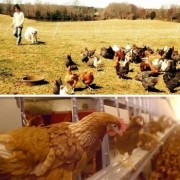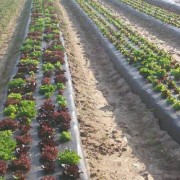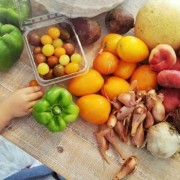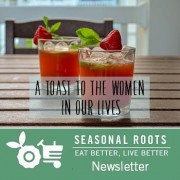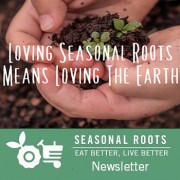Now on to the part where we tell you how to store fresh vegetables and fruit after your local farmers harvest it for you.
3. QC before you store fresh vegetables & fruits
Do a bit of quality control before you store your food. If there’s one mushy or moldy berry, toss it right away. A mushy item is a bad influence, and will lead everything that hangs out with it down the road to ruin.
4. Do wait to wash
You probably already know this. But, wait to wash until right before you eat it or cook it. Until then, leave it in its original state and handle it as gently and as little as possible. Excess moisture and bruising accelerate decay and nutrient loss.
5. Do wait to chop or peel
Store fresh vegetables and fruits whole. While we love meal-prepping, if you prep too far in advance, fresh fruits and vegetables lose those precious nutrients. So hold off on peeling or cutting them up until you’re ready to use them. Peeling and chopping expose the insides to oxygen and light and that kills nutrients. Once you do slice into something ahead of time, store it sealed up and in the fridge or freezer until it’s time to use it.
(Read more: 4 easy ways to max out your produce’s nutritional value)
6. Don’t wait to refrigerate fresh vegetables & fruits
For most fruits and veggies, a cold, dark place slows down decay and the loss of nutrients, because it inhibits destructive enzymes and the loss of vitamin C. B vitamins are particularly sensitive to heat and light.
There are exceptions and some items that should steer clear of the refrigerator — namely citrus and any fruit that could use some ripening, plus garlic, ginger, potatoes, onions, winter squash, zucchini, eggplant, and tomatoes.
7. Don’t crowd your crops
Make sure produce has room to “breathe” if it’s stored in a bag. If you cram too many items into a bag, more moisture builds up, more bruising happens, and the produce will spoil more quickly. You can also put a paper-towel inside the bag to absorb some of the excess moisture.
8. The humidity factor: A detour into the crisper drawer
In general, vegetables last longer in a more humid environment, while fruits prefer a slightly less humid environment. So store fresh vegetables separately from fresh fruit when you can.
The typical crisper drawer is nothing more than a partition inside your refrigerator that offers a more humid environment than the rest of the interior. Some crispers have a sliding humidity control setting that ranges from low to high. Sometimes they’re labeled “vegetables” (high) and “fruit” (lower than the veggie crisper but still higher than the rest of the fridge).
But of course, the real world isn’t as simple as these low-tech sliders, which usually just open or close a little vent in the drawer that allows moisture and ethylene gas to escape. The complicating factor is that ethylene gas.
9. Beware the ethylene gas!
It’s released by some fruits, including apples, apricots, melons, pears, peaches, plums, plus ripe tomatoes and avocados (but not unripe ones so much.)
Meanwhile, ethylene gas causes ethylene-sensitive produce to ripen faster, which includes most veggies and some fruits (apples, apricots, avocados, cantaloupe, grapes, limes, mangos, honeydew melons, peaches, persimmons, tangerines, and watermelon.)
So to keep the sensitive ones from turning into overripe mushes, you have to keep them away from the gassy ones. What do you do if a gassy emitter is also a sensitive hater, like an apple? As you’ll see on the cheat sheet at the end, you can keep it in the fruit crisper, or better yet on a shelf in the fridge.
If you’re the analytical type, here’s an in-depth chart that lists the optimal storage conditions for most veggies and fruits and whether or not they’re an ethylene emitter or an ethylene hater. If you want to totally geek out with this, we’ve created a PDF of the chart that you can download to print and post on your fridge. It will mark you as an expert in how to store fresh vegetables and fruits.
If you prefer a simpler guideline, here’s the ABC version:
10. The “How to Store Fresh Vegetables & Fruits” CHEAT SHEET: Store each item in its happy place
GET YOUR RED HOT PRINTABLE PDF DOWNLOAD OF OUR HANDY DANDY CHEAT SHEET RIGHT HERE!
Should it go on a shelf in the fridge? Or in one of the fridge’s crisper drawers? In a cool, dark pantry? Or a sunny window? At long last, here’s our handy dandy cheat sheet to make it easy:
When the storage advice for how to store fresh vegetables and fruits calls for plastic bags, you can always substitute plastic or glass storage containers for plastic bags. Store everything unwashed, uncut, and unpeeled. Wash and prep just before using.
APPLES: Can be stored on the counter or in the pantry for a few days. To prolong freshness, store on a shelf in the fridge or in a well-ventilated crisper, where they can last for a couple weeks. No need to bag them.
APRICOTS: Store on a shelf in the fridge or in a well-ventilated crisper, where they can last for a couple weeks.
ARTICHOKES: Store in the vegetable crisper.
ASPARAGUS: Store in a plastic bag in the vegetable crisper.
AVOCADOS: Regionally grown winter avocados from Florida can be stored on the counter or in the pantry for a few days. To prolong freshness, store on a shelf in the fridge or in a well-ventilated crisper. Do not bag them.
BEANS, GREEN OR LIMA: Wrap in a paper towel in a loosely closed bag in the vegetable crisper.
BEETS: Remove any greens and store them separately like other greens. Store beets in the vegetable crisper.
BERRIES: Store in single layers divided by paper towels, inside a loosely closed bag or perforated container in the fruit crisper.
BREAD: Store in an air tight container on the counter or in the pantry. In warm weather, if you can’t eat it within a few days, store it, sliced, in the freezer. (The fridge tends to dry bread out.) Defrost slices on the counter or briefly in the toaster and they’ll still be moist.
BROCCOLI: Place in a plastic bag in the vegetable crisper. Eat quickly; broccoli is surprisingly delicate.
BRUSSELS SPROUTS: Quite resilient! You can store them on or off the stalk in the vegetable crisper. If you cut them off the stalk, leave all the outer leaves intact for an extra layer of protection and seal them in a bag. When it’s time to cook them, remove any leaves that don’t look good.
CABBAGE: Store in a plastic bag in the vegetable crisper and it will last for weeks.
CANTALOUPE: Can be stored on the counter or in the pantry or on a shelf in the fridge.
CARROTS: Remove any greens and store them separately like other greens. Wrap carrots in paper towels in a plastic bag in the vegetable crisper. If carrots get soft, just drop them in cold water for a few minutes.
CAULIFLOWER: Wrap in paper towels and store in a plastic bag stem-side down in the vegetable crisper. Keep the head intact until use.
CELERIAC: Store in the vegetable crisper.
CELERY: Store in a plastic bag in the vegetable crisper. If it gets soft, trim the ends of the stalks and place in a glass of cool water, or soak the whole stalk in cold water, and that should perk it up.
CHERRIES: Cherries must, must, must be kept cold! Refrigerate in a plastic bag in the fruit crisper.
CITRUS: Regionally grown winter citrus from Florida tastes best when stored and eaten at room temperature, so store on the counter or in the pantry. But if you can’t eat it within a few days, pop it in the fruit crisper.
CORN: Store in the vegetable crisper in its husks but eat within a couple days. It can be roasted or grilled in its husks, too!
CUCUMBERS: Can be stored on the counter or in the pantry for a day or two. Otherwise, wrap individually in paper towels and store in a plastic bag in the vegetable crisper.
EGGPLANT: Can be stored on the counter or in the pantry. If you can’t eat it within a few days, seal it in a plastic bag in the crisper or on a shelf in the fridge, but eat within a week.
FIGS: Store in fruit crisper.
GARLIC: The kind that has a dry, papery outer skin and no greens can stay on the counter or in the pantry, or it can also be stored in the vegetable crisper.
GINGER ROOT: Store on the counter or in the pantry.
GRAPES: Seal in a plastic bag and store in the vegetable crisper, not the fruit crisper.
GREENS: Includes everything that is mostly green and leafy, from kale, bok choy, lettuce, and spinach, to spring onions, spring garlic, and leeks; also greens cut from the tops of root vegetables. Go through them and immediately discard any leaves that are beyond wilted. Store greens unwashed, wrapped in paper towels, inside a sealed plastic bag, in the vegetable crisper. Use them as soon as you can. They can be a bit delicate. Just make sure you wash before eating!
HERBS: Trim the ends of the stems (like flowers) and place in a glass of cool water on the counter until ready to use. This method will also help perk up any herb or greens, including celery, that may have wilted en route. To keep them going longer, you can put any herb except basil in the fridge, glass and all, with a plastic bag over it. But leave basil on the counter — the cold temps inside the fridge will quickly turn it black. You can still cook with it, but for fresh uses it gets pretty unappealing.
HORSERADISH ROOT: Store in the vegetable crisper.
JICAMA: Can be stored in a cool, dark corner of the pantry or countertop. You can also store them in the vegetable crisper.
KOHLRABI: Store in the vegetable crisper.
MANGOS: Regionally grown winter mangos from Florida can be stored on the counter or in the pantry for a few days. To prolong freshness, store on a shelf in the fridge or in a well-ventilated crisper. No need to bag them.
MELON, HONEYDEW: Can be stored on the counter or in the pantry or on a shelf in the fridge.
MUSHROOMS: Wrap in a paper towel and refrigerate in a breathable container (perforated plastic or a paper bag) in the vegetable crisper.
NECTARINES: If at all possible, do not refrigerate. It can produce mealy, tasteless fruit. Ripen on the counter and eat when ready.
OKRA: Place in a plastic bag in the vegetable crisper.
ONIONS: Store in a cool, dark corner of the pantry or countertop. You can also store them on a shelf in the fridge for longterm storage of a couple weeks or more. Never store them in plastic.
PARSNIPS: Remove any greens and store them separately like other greens. Wrap parsnips in paper towels in a plastic bag in the vegetable crisper. If parsnips get soft, just drop them in cold water for a few minutes.
PEAS, SNOW OR ENGLISH: Wrap peas that come in their pods in a paper towel and refrigerate in a breathable container (perforated plastic or a paper bag) in the vegetable crisper.
PEACHES: If at all possible, do not refrigerate. It can produce mealy, tasteless fruit. Ripen on the counter and eat when ready. If they’re not quite ripe and you’re in a hurry, they will ripen faster in a bag. But keep an eye on them — they may ripen very fast that way!
PEARS: Can be stored unwashed on the counter for a few days. To prolong freshness, store on a shelf in the fridge or in a well-ventilated crisper, where they can last for a couple weeks. No need to bag them. Wash just before eating. If they’re not quite ripe and you’re in a hurry, they will ripen faster in a bag.
PEPPERS, HOT OR SWEET: Store in a paper bag in the vegetable crisper, where they’ll keep for a week.
PLUMS: Can be stored on the counter or in the pantry for a day or two, or on a shelf in the fridge or in a well-ventilated crisper. If they aren’t quite ripe, they will ripen faster if you bag them.
POTATOES: Store in a cool, dark corner of the pantry or countertop. You can also store them in the vegetable crisper for longterm storage of a couple weeks or more. Never store them in plastic or in the same area as produce that releases ethylene gas — potatoes are highly sensitive!
RADISHES: Remove any greens and store them separately like other greens. Wrap radishes in paper towels in a plastic bag in the vegetable crisper.
ROMANESCO: Wrap in paper towels and store in a plastic bag stem-side down in the vegetable crisper. Keep the head intact until use.
RHUBARB: Store in a plastic bag in the vegetable crisper.
RUTABAGAS: Store in the vegetable crisper.
SPROUTS: Wrap in paper towels in a plastic bag in the vegetable crisper.
SQUASH, SUMMER: Yellow squash and zucchini can be stored on the counter. If you can’t eat it within a few days, seal it in a plastic bag in the crisper or on a shelf in the fridge, but eat within a week.
SQUASH, WINTER: Hard winter squashes, like acorn, butternut, and pumpkin, can hang out in the pantry or on the counter out of direct sunlight. If you store them in the fridge, keep them on a shelf, not in a crisper. They’re very hardy and can last a long, long time in the fridge. Big pumpkins do not need to be refrigerated at all.
SWEET POTATOES: Store in a cool, dark corner of the pantry or countertop. You can store them on a shelf in the fridge or the vegetable crisper, but be aware that fridge storage can sometimes alter their taste and flavor while cooking — but not always, so it’s okay in a pinch.
TOMATOES: Best on the counter, or in a sunny window if they need to ripen a bit more. But if you can’t get to them before they turn too ripe, you can store them on a shelf in the fridge. Just let them return to room temp before eating them raw – the cold can reduce the flavor, but most of it usually returns if you let it warm up.
TURNIPS: Remove any greens and store them separately like other greens. Store turnips in the vegetable crisper.
WATERMELON: Store on the counter or in the pantry. Can also be stored on a shelf in the fridge. Never store it in the same area as produce that releases ethylene gas — watermelon is highly sensitive!
11. When all else fails, freeze it!
If you can’t eat it all fast enough, just throw it in the freezer. It’ll keep there for 8-12 months! When you defrost it later, if it’s not as appetizing to eat raw, it’ll still be great cooked… and just about as nutritious as it would have been if you’d cooked it instead of freezing it in the first place.
And that’s how you store fresh vegetables and fruits so you can eat more fresh vegetables and fruits!
(Read more: How to freeze and save fresh local produce for a year!)
ABOUT SEASONAL ROOTS
Since 2011, Seasonal Roots’ online farmers market has connected Virginia families with local family farmers who use sustainable, humane practices. Our veggie fairies – mostly moms who believe in living better through scrumptious, healthy eating, being kind to animals, protecting the environment, and spreading joy – home-deliver freshly harvested produce, eggs, grass-fed dairy and meat, plus artisan fare. We empower our members to eat better and live better with more nutritious, flavorful food that’s good for us and good for the planet. More info at seasonalroots.com.
